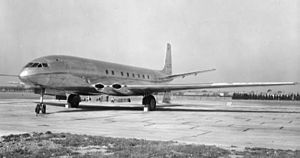
Back عصر النفاث Arabic Εποχή της αεριώθησης Greek Era del Jet Spanish عصر جت Persian Ère du jet French עידן הסילון HE ジェットエイジ Japanese 제트 시대 Korean Jetåldern Swedish Jet çağı Turkish
This article needs additional citations for verification. (September 2014) |

| History of technology |
|---|
The Jet Age is a period in the history of aviation defined by the advent of aircraft powered by jet turbine engines and the social and cultural changes fostered by commercial jet travel.
Jet airliners were able to fly higher, faster, and farther than older piston‑powered propliners, making transcontinental and intercontinental travel considerably faster and easier. Aircraft leaving North America and crossing the Atlantic Ocean (and later, the Pacific Ocean) could now fly to their destinations non-stop, making much of the world accessible within a single day's travel for the first time. Large jetliners could carry more passengers than piston-powered airliners, which caused air fares to decline and opened international travel to a broader range of socioeconomic groups.
In addition to pure jet engines, turbine-driven propeller engines delivered a smoother ride and better fuel efficiency. One exception to jet-powered domination by large airliners was the contra-rotating propellers turboprop design that powered the Tu-114 (first flight 1957). This airliner was able to match or even exceed the speed, capacity and range of contemporary jets, but such powerplants were only used in large airframes for military planes after 1976.
The introduction of the Concorde supersonic transport (SST) airliner to regular service in 1976 was expected to further revolutionize air travel by shortening travel times dramatically, but the aircraft never found commercial success. After two and a half decades of service, Concorde flights were discontinued in 2003 after a fatal crash near Paris in July 2000 and other factors. This was the only loss of an SST in civilian service. Only one other SST design was used in a civilian capacity, the Soviet era Tu-144, but it was soon withdrawn due to high maintenance and other issues. McDonnell Douglas, Lockheed and Boeing were three U.S. manufacturers that had originally planned to develop various SST designs since the 1960s, but these projects were eventually abandoned for various developmental, cost, and other practical reasons.[citation needed]